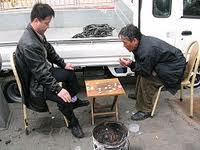shogi, and makruk, and related to xiangqi and janggi.
Chaturanga was developed in Gupta India around the 6th century. In the 7th century, it was adopted as Shatranj in Sassanid Persia, which in turn was the form that brought chess to late-medieval Europe.
Shogi also known as Japanese chess, Shogi means general in japanese, unlike modern chess, shogi has 9x9 squares, each player will have the following pieces, 1 king, 1 rook, 1 bishop 2 gold generals, 2 silver generals, 2 knights, 2 lances, and 9 pawns, similar to chess each player will have alternating moves and could be started by black's move. In a professional game there is an timekeeper assigned
One thing interest me about this game is that rooks when promoted will become dragon and bishop to horse.
 |
| Gary Kasparov playing Shogi |
Xiangqi is a two-player Chinese board game in the same family. The game represents a battle between two armies, with the object of capturing the enemy's "general" piece. Distinctive features of Xiangqi include the unique movement of the pao ("cannon") piece, a rule prohibiting the generals (similar to chess kings) from facing each other directly, and the river and palace board features, which restrict the movement of some pieces. Its Chinese name can be treated as meaning "Image Game" or "Elephant Game".
 |
| Chinese locals playing Xiangqi with their clothes as stakes |
Janggi is Korea's board game, very similar to xianqi, played in 9x10 board but without rivers.
 |
| Pride is at stake, less daring than the Chinese. |
Shatranj is an old form of chess, which came to the Western world from India, the initial piece setup is similar to modern chess, only the piece movements are not same as modern chess.
 |



Good post, so much information about chess in a single post and this is something new to me. Going to pass on the information with others, thanks for sharing this post
ReplyDelete